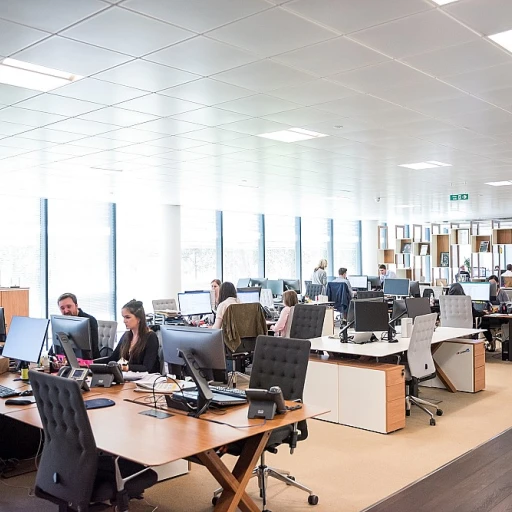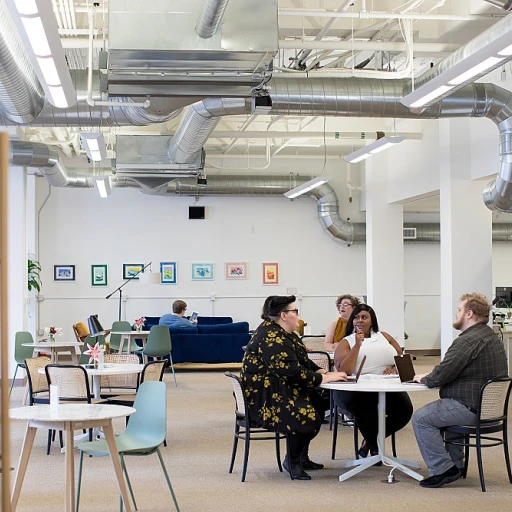
Understanding the Concept of Mix Staff
Exploring Diverse Talent Pools
A diverse staffing approach in the world of Managed Service Providers (MSP) signifies integrating various talents, skills, and backgrounds to meet unique business requirements. The concept of mix staff is rooted in the idea of assembling a workforce that's not only multi-faceted but also agile, allowing for a harmonious blend of creativity and specialized skills. This approach transcends traditional boundaries, connecting art and design expertise from places like art museums and universities, with strategic roles found in senior management and operations.
To truly unlock the potential of a diverse workforce within MSP settings, organizations often tap into talent from varied sources. Whether it’s hiring from the prestigious halls of university programs focusing on art and design, collaborating with curators from leading art museums, or leveraging digital media experts from film and advisory board backgrounds, the possibilities are diverse and enriching. For instance, teams can gain insights from directors currently working on innovative projects across art and film sectors or associate directors involved in daily operations at renowned institutions like the Hammer Museum in Los Angeles.
Integrating such talent fosters a culture of inclusiveness and a dynamic environment where traditional staff meets modern solutions. Directors of development, senior directors based in busy hubs like New York, and expertise from museum los settings can lead initiatives with fresh perspectives, driving both creative solutions and operational efficiency.
In today's rapidly evolving work landscape, employing a diversified staffing strategy can serve as the foundation for competitive advantage. To further explore strategies for optimizing your workforce, check out this article on optimizing MSP sales team structure.
Benefits of a Diverse Workforce in MSP
Diverse Perspectives for Enhanced Creativity and Problem-Solving
The incorporation of a diverse workforce in Managed Service Providers (MSP) leads to a treasure trove of creative solutions and unique perspectives. In fields such as art, design, and media, a mix of backgrounds and experiences can influence projects in unforeseen and innovative ways. A team that encompasses individuals from varied educational paths—from university studies in college art to engineering—enables fresh viewpoints that can fuel creativity.
Fueling Innovation in Complex Projects
In a city like Los Angeles, known for its vibrant art scenes like the Hammer Museum or the Museum of Art, a diverse workforce steeped in various cultural narratives can enhance projects by bringing in local inspirations. Those currently working in senior roles such as directors or curators often lead the charge in integrating these insights into their teams. This cross-pollination of ideas is often essential in streamlining development from conception to execution, ensuring that projects appeal to a wider audience.
Building Dynamic Teams with Varying Skill Sets
From the museum art curators in New York to the associate directors in Los Angeles, diversity in staffing also translates to a robust knowledge pool. When your team includes individuals skilled across different media and operations facets—from film to daily operations—you are inherently prepared to handle a broader range of customer needs and market challenges. The addition of award-winning professionals who have had their work exhibited in renowned colleges like Columbia University can be invaluable, imparting rich experiences to the team dynamics.
Staying Competitive in Evolving Markets
In the burgeoning landscape of MSP staffing, maintaining competitiveness requires focusing on diverse staffing approaches that align with market demands. By fostering an advisory board that welcomes voices from all walks of life, you not only enhance innovation but also lay the groundwork for engaging recruitment and development processes. Ultimately, this points to a critical conclusion: to thrive in today's market, diversity is not just a checkbox to tick—it's a strategic necessity.
Challenges in Implementing Mix Staff Strategies
Overcoming Hurdles in Integrating a Diverse Workforce
Implementing a mix staffing strategy within Managed Service Providers (MSP) presents its unique set of challenges. While the benefits are considerable, as discussed earlier, the path to realizing a truly diverse workforce requires overcoming various obstacles. Firstly, cultural diversity can lead to unexpected challenges in communication and team cohesion. With employees hailing from different backgrounds, misunderstandings in communication styles or cultural norms can arise. Training programs designed to educate staff about cultural intelligence and effective communication strategies are crucial in bridging these gaps. Another notable challenge is resistance to change. Senior leaders often find the shift towards diverse staffing daunting. For directors and senior directors familiar with traditional models, learning to embrace new methods can require a redefinition of leadership roles. Directors of operations may need to reassess their approaches to managing daily operations, especially in creative fields such as art, design, and media. Additionally, logistical challenges such as sourcing and integrating talent from various educational and professional backgrounds, like those associated with a university or art museum settings, can complicate staffing efforts. Developing partnerships with institutions like Columbia University or the Hammer Museum in Los Angeles for specialized roles (e.g., museum curator, art project lead) might require additional resources and strategic planning. Furthermore, measuring the success of such a diverse integration becomes complex. Identifying appropriate metrics that reflect the real impact on productivity and innovation while factoring in team dynamics takes careful consideration and often involves longitudinal studies and expert consultation. The management of these challenges requires both creative and carefully structured solutions. Successful implementation relies on adaptive leaders who remain committed to workforce development. Agile approaches to mix staff can not only address these challenges head-on but also set the stage for growth and innovation within the MSP sector. For insights on future trends and best practices, explore this informative resource on manufacturing staffing needs.Strategies for Effective Mix Staff Integration
Initiating and Enhancing Integration Processes
Effective integration of a mixed staffing model is crucial for achieving optimal workforce results. Different industries from art museum operations to media projects can benefit from a tailored approach to team integration. Here’s how you can manage these diverse elements seamlessly:
- Set Clear Objectives: Before diving into integration, it’s essential for senior directors and their teams to establish clear goals that reflect the diverse backgrounds of their staff. Whether you're in design, film, or museum art, these objectives should align with the organization's mission and core values.
- Embrace Multifaceted Communication Channels: The director of operations and university-based projects benefit from effective communication. From newsletters to daily operations meetings, ensuring that all staff are informed and involved helps in creating a cohesive work environment.
- Provide Training and Development Opportunities: Continuous development is key, especially when dealing with a mixed staff. Training programs should include workshops and seminars related to technology, art, or media solutions to upskill your team, from associate directors to new hires.
- Include Diverse Perspectives in Decision Making: Engage staff from various departments, whether they are working in an art museum like the Hammer Museum in Los Angeles or on media teams, to be part of the advisory board discussions and decision-making processes. This way, different perspectives are acknowledged and integrated into policies and strategies.
- Facilitate Team Building Activities: At institutions like Columbia University and beyond, organizing activities that encourage collaboration across departments can lead to more innovative solutions and a more unified staff.
To ensure success in implementing mixed staffing models, it’s pivotal to nurture a culture of inclusivity. By doing so, organizations not only optimize workforce capabilities but also enhance their creative and operational output through diverse perspectives and expertise.
Case Studies: Successful Mix Staff Implementations
Real-World Examples of Successful Mix Staff Integration
Implementing a mix staff strategy can be challenging, as discussed earlier, but the rewards are vast when executed correctly. To provide a clearer picture, let's delve into some successful implementations of these strategies across different sectors.
Art and Design Sector: A Collaborative Approach at the Hammer Museum
The Hammer Museum, located in Los Angeles, serves as a prime example where a diverse mix of roles, including curators, directors, and media professionals, collaborate to showcase art and design from various cultures. This institution integrates talents from Columbia University, college art enthusiasts, and award-winning curators. By blending their skills, the museum has developed innovative exhibitions and fostered an environment where diversity and creativity thrive.
Corporate Sector: Dynamic Team Building in New York
In New York, a prominent company has found success by integrating a diverse staff base across its senior and director-level teams. With the inclusion of associates from different educational backgrounds, such as university graduates from various fields, the company has been able to launch projects that appeal to a broad audience. This approach not only boosts creativity but also enhances problem-solving capabilities, creating dynamic teams adept at handling complex challenges.
Media and Film Industry: Innovative Solutions in Los Angeles
The film industry in Los Angeles has long been a proving ground for innovative staffing solutions. Here, media and film directors integrate a mix of talent from promising young students to seasoned senior directors to drive forward-thinking film projects. This diversity allows for fresh perspectives and has led to award-winning outcomes, proving that varied teams can achieve remarkable milestones.
University Studies: Embracing Diversity for Development
At Columbia University, studies have shown that departments that adopt a diverse staffing approach gain numerous advantages. By incorporating individuals from various cultural and educational backgrounds, the university has seen significant development in their research projects. This multidisciplinary approach enhances creativity and facilitates groundbreaking studies, reflecting the profound benefits of a mix staff strategy.
From art museums to corporate settings, these case studies exemplify how the effective integration of mix staff strategies can lead to successful outcomes. As the workforce continues to evolve, these examples offer invaluable lessons on the potential of diverse teams. As organizations aim to optimize their staffing efforts, these proven methodologies can provide a blueprint for future success.
Future Trends in MSP Staffing
Emerging Trends in MSP Staffing
As we look towards the future of MSP staffing, several trends are shaping the landscape. These trends are influenced by technological advancements, evolving workforce expectations, and the increasing importance of diversity and inclusion. Organizations are recognizing the value of a diverse mix of skills and backgrounds, which is crucial for innovation and problem-solving.
Technological Integration and Automation
Technology continues to play a pivotal role in MSP staffing. Automation and AI are being integrated into daily operations, allowing for more efficient processes and freeing up staff to focus on strategic initiatives. This shift requires a workforce that is adaptable and skilled in digital tools, emphasizing the need for continuous learning and development.
Remote Work and Flexibility
The pandemic has accelerated the adoption of remote work, and this trend is here to stay. MSPs are increasingly offering flexible work arrangements to attract and retain top talent. This flexibility is particularly appealing to senior professionals and directors who are currently working in dynamic environments like art museums or media projects in cities such as Los Angeles and New York.
Diversity and Inclusion as a Strategic Imperative
Diversity and inclusion are no longer just buzzwords; they are strategic imperatives. Organizations are actively seeking to create teams that reflect a mix of backgrounds, experiences, and perspectives. This approach not only enhances creativity and innovation but also aligns with the values of younger generations entering the workforce.
Focus on Skills Development
With the rapid pace of change, continuous skills development is essential. MSPs are investing in training programs to ensure their teams are equipped to handle emerging challenges. This includes partnerships with universities and colleges, such as Columbia University, to provide cutting-edge education and training opportunities.
Collaborative Leadership Models
Leadership in MSPs is evolving towards more collaborative models. Directors and senior leaders are working closely with their teams to foster an environment of trust and innovation. This approach is particularly effective in creative fields like art and design, where collaboration is key to success.
As MSPs navigate these trends, the focus remains on creating a workforce that is adaptable, diverse, and equipped to meet the challenges of the future. By embracing these changes, organizations can optimize their staffing strategies and drive sustainable growth.












